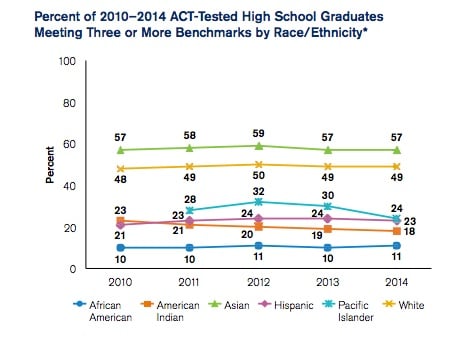Let’s acknowledge that “tests are often designed with racial, cultural, and socio-economic bias built in.” (How to Address Racial Bias in Standardized Testing | NGLC (nextgenlearning.org, Still Mostly White and Female: New Federal Data on the Teaching Profession (edweek.org) Naturally enough, white teachers may not flag problematic test questions. The cultural references in those tests are THEIR cultural references, resulting in questions make perfect sense to people living inside the bubble of whiteness.
But another, insidious and damaging institutional aspect of testing needs to be called out as racist. I hope I can lay this out clearly. I retired from a district that put the “wrong” in “wrong side of the achievement gap.” Our standardized test scores were so disastrous that the department of education for the state of Illinois fired our board and effectively took over the district. As I write this, I am reminded of a favorite quotation:
If you hold a cat by the tail, you learn things that cannot be learned in any other way.
mark twain
What are the demographics for my district? According to the Illinois Interactive Report Card site, which I highly recommend, my middle school is currently 61% Hispanic, 30% black, 5% two or more races, and 4% white. The school is 99% low income. Chronic absenteeism runs high. This is defined as “students who miss 10% percent or more of school days per year either with or without a valid excuse.” In 2018, that rate was 29%, and it rose to 38% in 2019. Chronic absenteeism fell to 18% in 2020, but I’m sure that number’s impacted by COVID.
I could throw in many more numbers but I would say those numbers for chronic absenteeism, in and of themselves, explain a great deal of the school’s poor scoring history on annual state standardized achievement tests. I don’t want to immerse readers in the many fascinating numbers that our poorest schools are posting. I want to share a big picture that I saw in my classroom.
Students of color fill the hallways of my school. Like almost all the other students in Illinois, they take the annual spring state achievement test. Schools across Illinois are all taking the same test. Different versions of this story happen in all fifty states. When we focus on the content of that test and the implicit bias in some of its questions, though, we miss the reason why I want parents to opt out this year. We miss the reason why testing as it currently executed should be SHUT DOWN.
Who are the children taking the most psychological damage from these tests? I’ll give readers one guess, and the answer is so not “the white kids.” Oh, individual white kids are undoubtedly getting hammered all over the country. But we have decades of evidence showing that children of color form a disproportionate number of those performing poorly on these tests.
These are the kids whose self-images are being defined by persistently low scores. These are the kids who end up disproportionately — and it’s all in the proportions — feeling like crap when the test results come back. Somehow, it seems as if our government and education leaders believe that children are oblivious to their own test results, despite the emphasis schools are now placing on those results.
(That emphasis was captured beautifully in a quote from a seventh-grade boy in my math class on a spring day when the tests had just ended: I pulled out the day’s work and he said, “More math? Why do we have to do more math? The tests are over.”)
As I click my way across the internet, I find articles with titles like “How to Address Racial Bias in Standardized Testing.” Here’s what I would like to make crystal clear today: YOU CAN’T DO IT. YOU CAN’T FIX THE BIAS. Even if you took some or almost all of those white-centric cultural biases out of the tests, the tests themselves — ANY STATE STANDARDIZED TEST — creates a bias in standardized testing that transcends the content of the test. Here’s one graph that explains what I just wrote:

Here’s another:

I invite readers to try various searches on test results by race. The search itself is interesting if you are mathematically inclined. What turns up is remarkably consistent. The Asian line is on top, followed by the white line, followed by the Hispanic line. Other subgroups end up criss-crossing the Hispanic line. The black line comes in at the bottom. That’s the results that our tests produce. You can find a few exceptions with Asian bilingual students on top in math but trailing whites in English, for example. But I remember where I first learned about this, at a professional development put together by a woman of mixed-race who was working to figure out how we might address the problems posed by these lines.
“The graphs always look like this,” she lamented.
Let’s ignore the cultural biases in the tests that might produce these results for the moment. Let’s just look at one fact: Kids are seeing these scores. In some cases, they are even having their noses rubbed in their scores by well-meaning administrators and teachers who hope to motivate them to do better.
Kids are forming their self-images based on these scores. I guarantee it. My last principal demanded teachers go over MAP benchmark test scores with all our students, showing them their score against the national average. The idea was to push them to try harder in school.
I’m at one of those moments where I put my hands in my lap and wonder if there is any point in going on. Sometimes I end up feeling trapped in a treacle of good-intentioned twaddle. It’s no coincidence I retired that year. Did those scores motivate my students? Maybe in a few higher-functioning cases. But my bilingual students were fairly far behind the English-language-learning pack. That’s why they had been placed in self-contained bilingual classes.
Mostly those scores sucked the life out of my students. Mostly those scores made them feel stupid. Even students who might have been labeled as gifted if they had spoken English before they arrived in this country at 14 years of age felt demoralized. Maybe those gifted students felt especially demoralized. They could see the chasm between their scores and the scores they were supposed to reach. They could immediately understand how far behind they were when compared to that so-called “average” child.
The same hopelessness was being experience by certain children in the special education classroom on the other side of the hallway. Lower-scoring children all across this country are hurting. Before we keep testing the bejeezus out of all our students — I think our leaders need to ask themselves: Who are the children who are performing poorly on these tests and how does this performance affect their view of themselves.
I’m just dumb, Ms. Turner.
various students over time
“I’m just dumb, Ms. Turner,” students have told me when asked why a quiz or some other activity did not go well. I don’t know how many times I’ve heard that. I didn’t tell them that. I hope no one ever told them that. No, my students drew that conclusion for themselves, and I strongly believe that those annual test scores are a big factor in convincing many children that they are “dumb.”
It’s not a surprising conclusion to draw if your state test scores put you in the bottom quartile of all state test results. BUT THAT BOTTOM QUARTILE CONTAINS 25% OF AMERICA’S CHILDREN — millions and millions of our children. We have elevated the importance of standardized test scores into the stratosphere over the last few decades. Do we think the kids were not paying attention as we added those assemblies about the importance of taking the test seriously? Do we think kids are not always trying to figure out where they stand in respect to their peers?

Eduhonesty: Oh, please, please, please. I feel betrayed by the Biden administration right now. I understand the desire to measure to get data. But do you want to know why rates of anxiety and ADHD have shot up in schools across the nation, reader? I feel certain at least part of that change stems directly from the pressure adults are putting on children to do well on these tests.
Children are not oblivious to today’s testing mania. Children try hard to please, at least initially. We are cracking eggs to make our test score omelette, and those eggs are children.
Make no mistake, the graphs above lay out a particularly pernicious truth that is part of what I have written here: Current testing has become a disaster for many kids ESPECIALLY KIDS OF COLOR. You just have to look at the above graphs to realize that proportionally more harm — sometimes much more harm — is falling on kids of color. The kids toward the bottom of our score graphs are taking more and harder hits over time.
You want to see racism in action? Standardized tests are a perfect place to look — and not merely because of the content of questions. Those tests are shaping the personal image and worldview of our students. Visualize those tests as a running race. When nine out of ten kids come in ahead of you at the finish line, even though you tried your hardest, how do you feel? If this happens year after year, will you keep racing? Honestly, what will happen to the kids who always straggle in late or last?
One more thought: I wonder if we would so casually ignore the pain we are causing to children and young adults across the country if those children were mostly all white? I don’t think so. RACISM is about the only explanation I can find for that lack of concern for the psyches of the children in this testing experiment. That racism may not be overt or intentional, but nonetheless I believe it’s there.
If we want to fix the achievement gap, we have to shut down toxic testing. That gap cannot be fixed unless kids believe in themselves, unless kids can see themselves winning that running race. State standardized tests work directly against that self-confidence.
At the moment, we are producing a generation of kids who are more likely to say, “I just can’t run, Ms. Turner,” instead of “I will try harder next time.”
_______________________________________________________________________
Phone number for the US Department of Education: 1 (800) 872-5327
On Twitter? Secretary Miguel Cardona@SecCardona
Thanks to all my readers, Jocelyn Turner
